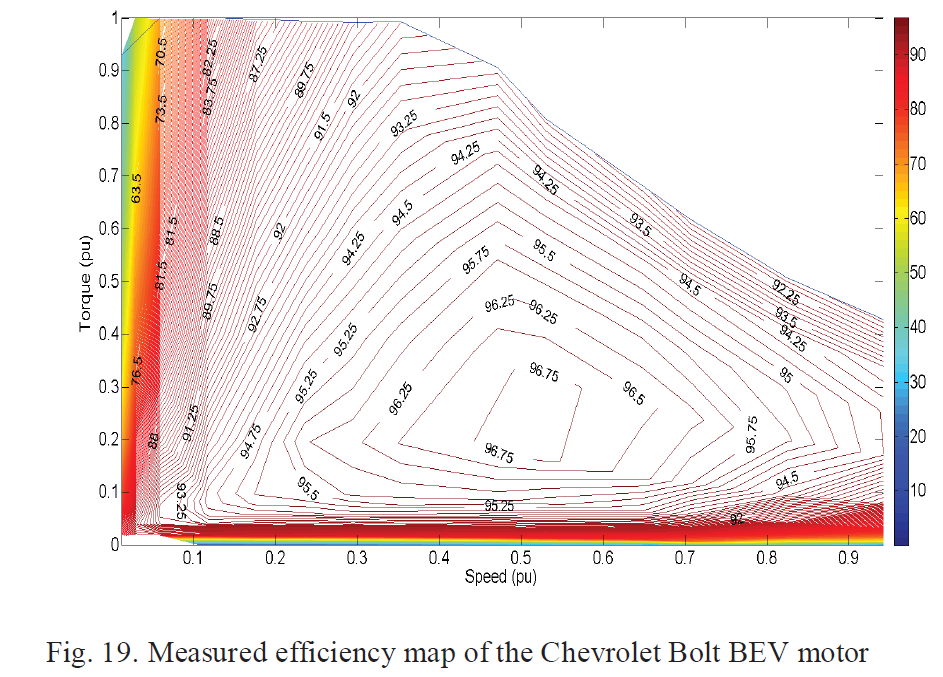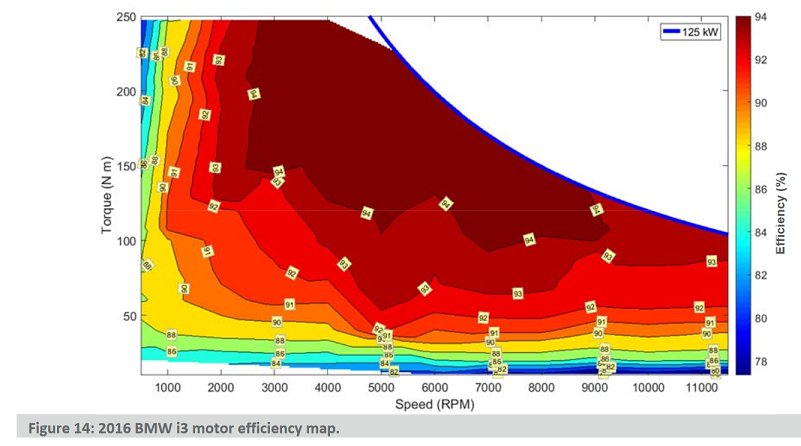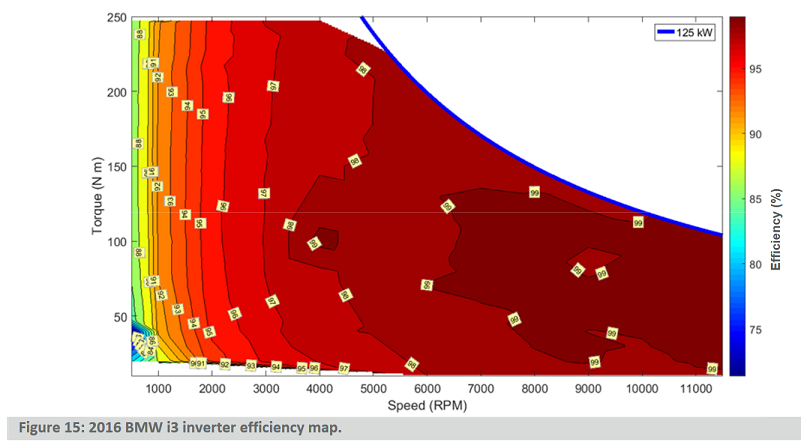Taycan Turbo - EPA rated 201 miles
#196
Unless Porsche's motor engineers slept through the last few decades of developments (i.e., can't match the Model S induction design's performance tracing it's roots to the mid-90s), motor efficiency can't be more than a few % behind Tesla's latest - there just isn't that much to gain when starting in the 90% range.
On the one hand, it means Tesla doesn’t have some magical technology lead that no one else can replicate. On the other, years of experience and refinement .... takes years to develop. Porsche has some work to do. 5 years behind Tesla appears to still put them 2 years ahead of everyone else ...
#197
Unless Porsche's motor engineers slept through the last few decades of developments (i.e., can't match the Model S induction design's performance tracing it's roots to the mid-90s), motor efficiency can't be more than a few % behind Tesla's latest - there just isn't that much to gain when starting in the 90% range.
Induction motors have been around since the 1890s, if not before. Nichola Tesla himself invented variations of them. But they were thought of as fixed speed AC motors and so really hadn't been used in EVs until the EV-1 in the 1990s. Though GM was playing with driving them with variable frequency/high power inverters as far back as in the 1960s (e.g. the Electrovair II prototype). They have advantages and disadvantages compared to DC brushless motors with magnets in them. Up until the Model 3, Tesla exclusively used induction motors. Now they use a PMSRM on one axle, and in dual motor cars, induction on the other. The PMSRM motor is a reluctance motor with some PM added to smoothen it out. (Sorry acoste but it is yet another variation from what is in the i3.)
#198
The efficiency of the motor is just one small part of the overall system’s load upon the batteries. There are many other components and power costs. Tesla’s cost effective and power efficient thermal management is one example. HVAC is another. CoD, regen efficiency ... There are many more, and a lot of ways to lose 1% here and a % there to wind up with 45% less overall. Tesla has a 10+ year head start in finding those little cuts and figuring a cost acceptable resolution. This engineering is extremely difficult and Tesla is state of the art.
On the one hand, it means Tesla doesn’t have some magical technology lead that no one else can replicate. On the other, years of experience and refinement .... takes years to develop. Porsche has some work to do. 5 years behind Tesla appears to still put them 2 years ahead of everyone else ...
On the one hand, it means Tesla doesn’t have some magical technology lead that no one else can replicate. On the other, years of experience and refinement .... takes years to develop. Porsche has some work to do. 5 years behind Tesla appears to still put them 2 years ahead of everyone else ...
#199
All of this has me thinking that Porsche should have stuck with what they are good add. Building a two seater sports car. Their first EV should have been the electric Boxster/Cayman. No one would have cared about range and efficiency. They probably could have made it less luxurious and lighter weight, using a smaller battery pack and therefore offered it for a lower cost as well. This would have been a better introduction and allowed them to work out the efficiency stuff over time. The Taycan crosses too much into the everyday driver market and this is where the range will really hurt it. Combine that with the ****ty charging infrastructure structure (read the article about charging issues with the E-tron) and they are setting themselves up for a lot of pissed off customers.
The following 4 users liked this post by manitou202:
#200
The efficiency of the motor is just one small part of the overall system’s load upon the batteries. There are many other components and power costs. Tesla’s cost effective and power efficient thermal management is one example. HVAC is another. CoD, regen efficiency ... There are many more, and a lot of ways to lose 1% here and a % there to wind up with 45% less overall. Tesla has a 10+ year head start in finding those little cuts and figuring a cost acceptable resolution. This engineering is extremely difficult and Tesla is state of the art.
On the one hand, it means Tesla doesn’t have some magical technology lead that no one else can replicate. On the other, years of experience and refinement .... takes years to develop. Porsche has some work to do. 5 years behind Tesla appears to still put them 2 years ahead of everyone else ...
On the one hand, it means Tesla doesn’t have some magical technology lead that no one else can replicate. On the other, years of experience and refinement .... takes years to develop. Porsche has some work to do. 5 years behind Tesla appears to still put them 2 years ahead of everyone else ...
The following users liked this post:
JB43 (12-23-2019)
#201
RL Community Team
Rennlist Member
Rennlist Member
Joined: Jan 2013
Posts: 8,955
Likes: 2,639
From: The Woodlands, TX.
All of this has me thinking that Porsche should have stuck with what they are good add. Building a two seater sports car. Their first EV should have been the electric Boxster/Cayman. No one would have cared about range and efficiency. They probably could have made it less luxurious and lighter weight, using a smaller battery pack and therefore offered it for a lower cost as well. This would have been a better introduction and allowed them to work out the efficiency stuff over time. The Taycan crosses too much into the everyday driver market and this is where the range will really hurt it. Combine that with the ****ty charging infrastructure structure (read the article about charging issues with the E-tron) and they are setting themselves up for a lot of pissed off customers.
So while I do agree with some of your points, I think that those cars are too important to be the guinea pigs. Think about it, if they flub the electric 718, their entire idea of electric sports cars takes a huge hit. The idea of an electric Porsche in general takes a huge hit. The Taycan is super fast and comfortable and handles well. Porsche is likely embarrassed at the range and won't sell as many as they could have if it was better, but they will still get sales, and they will still learn how to make the next generation of EV's better. But without harming their core brand. And without losing money, since they are charging so much.
I think this path makes the most sense.
The following 5 users liked this post by Needsdecaf:
4pipes (12-13-2019),
AlexCeres (12-13-2019),
daveo4porsche (12-13-2019),
JB43 (12-23-2019),
Thinc2 (12-13-2019)
#202
I disagree. That's too radical. Look at the furor on here about an electric 4 door, something not core to the Porsche brand. There are a lot of take it or leave it scenarios that can have people leave it if desired. Also, it's high price and somewhat low volume for Porsche. So they can afford to charge the customer for a little R&D cost, learn from "the fleet" data, and then step it up when they go to build the Macan EV. Because let's face it, that's their best seller by volume. They can't afford to boot that in any way. And then when the 718's get replaced by EV's, well, they had better have no excuses when they make an electric SPORTS CAR.
So while I do agree with some of your points, I think that those cars are too important to be the guinea pigs. Think about it, if they flub the electric 718, their entire idea of electric sports cars takes a huge hit. The idea of an electric Porsche in general takes a huge hit. The Taycan is super fast and comfortable and handles well. Porsche is likely embarrassed at the range and won't sell as many as they could have if it was better, but they will still get sales, and they will still learn how to make the next generation of EV's better. But without harming their core brand. And without losing money, since they are charging so much.
I think this path makes the most sense.
So while I do agree with some of your points, I think that those cars are too important to be the guinea pigs. Think about it, if they flub the electric 718, their entire idea of electric sports cars takes a huge hit. The idea of an electric Porsche in general takes a huge hit. The Taycan is super fast and comfortable and handles well. Porsche is likely embarrassed at the range and won't sell as many as they could have if it was better, but they will still get sales, and they will still learn how to make the next generation of EV's better. But without harming their core brand. And without losing money, since they are charging so much.
I think this path makes the most sense.
The following users liked this post:
Needsdecaf (12-13-2019)
#204
Oh, I have my ideas where several of Porsches problems are. I've shared a couple on these threads and gotten flamed as a result. So... we'll see.
Induction motors have been around since the 1890s, if not before. Nichola Tesla himself invented variations of them. But they were thought of as fixed speed AC motors and so really hadn't been used in EVs until the EV-1 in the 1990s. Though GM was playing with driving them with variable frequency/high power inverters as far back as in the 1960s (e.g. the Electrovair II prototype). They have advantages and disadvantages compared to DC brushless motors with magnets in them. Up until the Model 3, Tesla exclusively used induction motors. Now they use a PMSRM on one axle, and in dual motor cars, induction on the other. The PMSRM motor is a reluctance motor with some PM added to smoothen it out. (Sorry acoste but it is yet another variation from what is in the i3.)
Induction motors have been around since the 1890s, if not before. Nichola Tesla himself invented variations of them. But they were thought of as fixed speed AC motors and so really hadn't been used in EVs until the EV-1 in the 1990s. Though GM was playing with driving them with variable frequency/high power inverters as far back as in the 1960s (e.g. the Electrovair II prototype). They have advantages and disadvantages compared to DC brushless motors with magnets in them. Up until the Model 3, Tesla exclusively used induction motors. Now they use a PMSRM on one axle, and in dual motor cars, induction on the other. The PMSRM motor is a reluctance motor with some PM added to smoothen it out. (Sorry acoste but it is yet another variation from what is in the i3.)
Having said that BMW is moving back to AC induction motors from 2021 in order to avoid using rare earth materials.
There isn't much room for improvement left here.

#205
i3 and Bolt is the same, permanent magnet assisted synchronous reluctance motor. As BMW says it "a proprietary hybrid synchronous motor designed to exploit both permanent magnets and the reluctance effect". https://www.greencarcongress.com/201...-20130812.html
Having said that BMW is moving back to AC induction motors from 2021 in order to avoid using rare earth materials.
There isn't much room for improvement left here.
Having said that BMW is moving back to AC induction motors from 2021 in order to avoid using rare earth materials.
There isn't much room for improvement left here.
All Model S and X vehicles now benefit from Tesla’s latest generation of drive unit technology, which combines an optimized permanent magnet synchronous reluctance motor, silicon carbide power electronics, and improved lubrication, cooling, bearings, and gear designs to achieve greater than 93% efficiency.
https://www.tesla.com/blog/longest-r...s-even-farther
It is not clear to me what is included in the 93%. My understanding is that this is the whole drive unit's efficiency. Is the battery included? Probably not. (Round trip efficiency of the Model 3's battery is 95.5%) Transmission is possibly included, those are usually in the 99% range.
Now here is the BMW i3 that doesn't have the better SiC inverters yet unlike the Model 3 (GaN inverters are the best but I don't know anyone using them).
Notice that the Bolt motor is tuned in a way that efficiency drops with increasing torque while the i3's efficiency increases. BMW motor does not favor the EPA test cycle which contains light acceleration only.



#206
Porsche has two optics problems
A $35k Tesla with 30% dead cells has more range than Taycan
a Model X towing a Taycan on a dolly has more range than a Taycan
The 4S with 225/275 tires is going to fare much better in EPA range
A $35k Tesla with 30% dead cells has more range than Taycan
a Model X towing a Taycan on a dolly has more range than a Taycan
The 4S with 225/275 tires is going to fare much better in EPA range
#207
As any long-time EV owner knows when you account for the need to only charge the batteries up to 80% when using the car daily and not to damage or shorten the charging cycle of the batteries even the 4S will probably only do 129 miles on 80% power as a daily driver.... I will be canceling my order and going back to the MS
The following users liked this post:
JB43 (12-23-2019)
#208
As any long-time EV owner knows when you account for the need to only charge the batteries up to 80% when using the car daily and not to damage or shorten the charging cycle of the batteries even the 4S will probably only do 129 miles on 80% power as a daily driver.... I will be canceling my order and going back to the MS
All long time EV owners also know that different vendors have different provisioning strategies to mitigate the impact of charging all the way up to (GASP!) 82 or 84 or even, heaven forbid 89%. There is nothing magical about 80% unless a company is really aggressively promoting range and has a small amount of under provisioning.
By the way, 80% of 200, is 160. So if you need an extra 31 miles on top of that, you are probably too conservative to drive a Porsche.
#209
As any long-time EV owner knows when you account for the need to only charge the batteries up to 80% when using the car daily and not to damage or shorten the charging cycle of the batteries even the 4S will probably only do 129 miles on 80% power as a daily driver.... I will be canceling my order and going back to the MS
The following 2 users liked this post by acoste:
beaudawg (12-14-2019),
daveo4porsche (12-13-2019)
The following users liked this post:
JB43 (12-23-2019)


